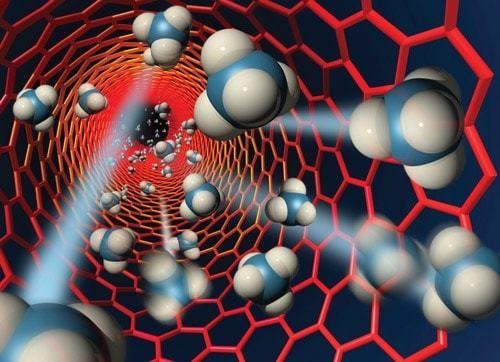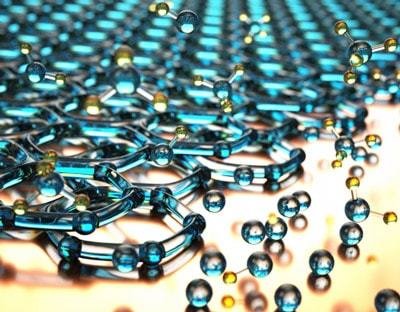What is Nanotechnology?

Presented by


Examples of Nanotechnologies
As you watch, think about:
- What do you think is special about these items? What is catching your attention?
- How did they seem different from normal things you have seen before?
- What properties have nanotechnology changed?
- What is now possible with nanotechnology that was not possible before?

Examples of Nanotechnologies
As you watch, think about:
- What do you think this video is made from, what are the moving dots?
- Do you think there is any nanotechnology in this video? If yes, what?

Examples of Nanotechnologies
As you watch, think about:
- What is happening in the video?
- What is interesting?
- How do you think the features are related to nanotechnology?
- What is now possible with nanotechnology that was not possible before?

Why learn nanotechnology?
There is a world-recognized relationship between education in science and engineering and innovation and prosperity.

Learning nanotechnology will:
-
Give you the knowledge and skills to understand the principles of 21st century technologies.
-
Provide you with the expertise to navigate the rapidly innovating high-tech economy of the near future!
-
Keep you current with the world around you instead of trying to catch up.
Nanotech All Around Us
- Over 1,800 products are listed in the Project for Emerging Nanotechnologies' Consumer Product Inventory.
- See the full list: http://www.nanotechproject.org/cpi/products/
- You may not realize just how many products and benefits nanotechnologies have already brought you.

Nano and Innovation
- Nanotechnologies are at the forefront of innovation.
- Nanomaterials are opening up new doors for research and development (R&D) of many new and exciting products.
- The R&D 100 Awards recognize each year’s top 100 technology products; in 2013, half of the products were nanotech-based.
-
-
Example: NanoMech’s TuffTek
- A self-lubricating series of cutting tools.
- These can eliminate the need of over 100 million gallons of cutting fluid that is used each year in the U.S. to protect wet machining tools.
-
Example: NanoMech’s TuffTek


Your Career and Nanotechnology
In the very near future, nanotechnology will have a direct impact on your life – regardless of your location, career, or social position.
- Jobs will be effected both...

It is important for every student to have a good understanding of nanotechnology!
-
Directly:
- scientists
- engineers
- technicians
- professors
-
Indirectly:
- attorneys
- medical personnel
- architects
- environmental activists
- athletes
- businessmen
- politicians
- investors/VC's
- artists, etc.
A Future Nanotech Economy


By 2018:
- Over 8,600,000 U.S. STEM jobs (U.S. Bureau of Labor Statistics)
- 17% growth in STEM jobs vs 9.8% for non-STEM.
By 2020:
- NSF estimates that nanotech will employ 6 million workers in the manufacture of nanomaterial-based products.
Make sure you learn the skills required to get one of the millions of jobs available!
Nanotechnology allows scientists to manufacture revolutionary materials with both fun and useful applications!
In this video...
-
The climbing robot is designed to mimic the gecko's structure.
-
Like the gecko, the feet of this robot have microscopic hairs 1/10th the size of a human hair.
-
These microscopic hairs, being so close together, drag across a vertical surface, allowing the robot and the gecko to climb high.
Fun in Nanotechnology
A career in nanotechnology offers all sorts of fun opportunities like this one!

Where will nanotech be used?
Nanotech will be used in a variety of disciplines and fields

-
It will lead to finding new solutions to long-standing problems in the fields of:
- Medicine
- Energy production and storage
- Environmental conservation
- Communication
- Computation
- Defense/warfare
What is nanotechnology?
Nanotechnology is a new and highly interdisciplinary field of science and engineering, embracing concepts from:

Nanotech deals with the manipulation of very tiny materials called:
nanomaterials
- Chemistry
- Physics
- Biology
- Mathematics
- Materials Science
- Engineering
- Computer Science
nan·o·tech·nol·o·gy
- Nanotechnology is the understanding and control of matter at dimensions between approximately 1-100 nm.
- Nanotechnology provides materials!!
- Matter and materials = “nanomaterials”
- Structures = “nanostructures”
- Nanomaterials and nanostructures are artificial (i.e., man-made)
Nanotechnology is entirely based on and enabled by these nanomaterials and nanostructures.


Nanotech Provides Materials!!
Remember, without nanomaterials and nanostructures, there is no nanotechnology!
Examples of nanomaterials:
At nanoscale dimensions, unique phenomena enable new applications that were previously unachievable with bulk materials.
- For the first time, scientists are more concerned with making materials of a desired shape and size than materials with a desired chemical composition.
- An important distinction between nanotechnology and (example) computer science or math: nanotechnology provides its own unique materials.

Many Types of Nanomaterials
- In the past 15-20 years, scientists have created and developed 100s to 1000s of different nanomaterials and nanostructures.
- Entirely new nanomaterials and new properties of existing nanomaterials are still being discovered on a monthly basis!

New Materials = New Opportunities
The availability of new materials usually:
- Enables new technologies
- Improves overall quality of life
- Offers new economic opportunities
- Strengthens our military forces

New Materials = New Opportunities
- Throughout history, each time new materials have become widely available, it has become possible to do new things.
- Leads to new technologies and economic opportunities, increased military strength, and an overall improvement in quality of life.
- The Industrial Revolution shifted our societies from agricultural to industrialized/urban (more modern) in the mid-19th century when materials such as coal, copper, oil, and steel started to become widely available.
- Currently, we are entering a new phase of industrial revolution, the “21st-century Industrial Revolution” or the “Nanotechnology Revolution”; enabled by the availability of new nanomaterials.

The New Revolution
However, the Nanotechnology Revolution and old Industrial Revolution will be very different.
The Nanotechnology Revolution
- Will have substantial government oversight.
- Require a highly-skilled STEM workforce.
- Will develop clean technologies to fix the problems of the Industrial Revolution.
- Lead to large-scale IP/patent development.
- This revolution will occur on a global scale because so much information is shared (e.g., published in scientific journals).
The 19th-century Industrial Revolution
- Little government oversight and few rules.
- Led to an exploited and unskilled labor force.
- Led to a plethora of pollution.
- It occurred on a country-by-country basis, beginning in England and the U.S. and slowly expanding.
The Importance of New Materials
The availability of a new material can drastically change an entire field.
For example: Architecture & Steel
- For thousands of years, tall structures required a very large base for support.
- The wide availability of steel (~mid-19th century) changed architecture forever.
-
Buildings could be built tall and straight, without the need of a wide base because of steel's high strength to weight ratio.
- Think of any downtown city and you will see how
a single material is a GAME CHANGER.
- Think of any downtown city and you will see how





More Game-Changing Materials
For example: Skateboarding and Polyurethane
- Previously, skateboard wheels were made of clay and could only move in a straight line.
- In 1972, the polyurethane wheel was invented.
- Polyurethane wheels were wider and softer, enabling an increased range of movement and the modern skateboarding tricks you see today.







Nanomaterials are Game-Changing
Nanomaterials are game-changers for so many new products and fields.

Nanomaterials lead us to...
- We are still discovering and creating new ways to use the nanomaterials we have.
- AND new materials are still being made.
Endless Possibilities

In the next few years, nanomaterials and nanostructures will lead to the development of exciting new technologies





- Cloaking/invisibility devices
- Super stealth aircrafts
- Flexible electronics
- Wearable electronics
- Superior solar panels
Future Applications
- Nanomaterials are the basic “ingredients” to even further create the technologies of tomorrow
- Scientist and engineers are constantly trying to push forward, discovering and creating things previously not thought possible
- Although many of these products don't exist yet, like the space elevator, it’s fair to say these projects are all under development

In-Class Assignment
Using your own words:
- Why do you think it’s important to learn nanotechnology?
- What does nanotechnology provide?
- Name three careers that are affected by nanotechnology.
- Throughout history, every time we have had new materials we also had opportunities to…

This lesson was prepared by:
To learn more about nanotechnology, visit omninano.org



